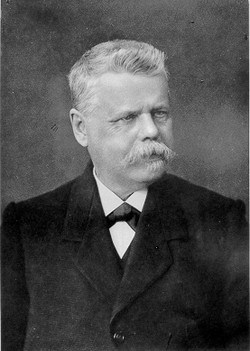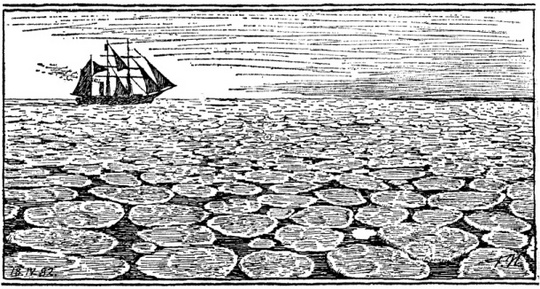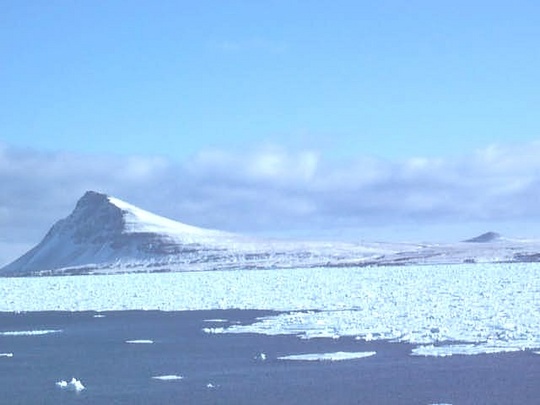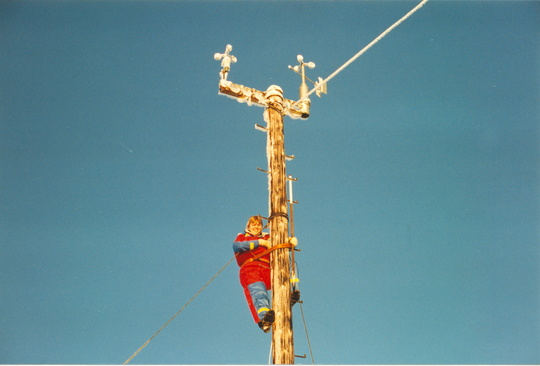Early work and an overview of measurements
Secular variations of the climate of Iceland 1
Evaluation of the history of climate in Iceland since the settlement has been ongoing for more than two hundred years. Hannes Finnsson, the bishop of Skálholt wrote the first scientific treatise on the subject in 1796 (Finnsson, 1796). The great naturalist and geologist Þorvaldur Thoroddsen collected documentary material into a volume on the climate history of Iceland in 1916 (Thoroddsen, 1916) and later Jón Eyþórsson, Sigurður Þórarinsson and Páll Bergþórsson wrote papers on the subject (see references).
Bergþórsson (1969) made the first attempt to quantify the temperature variability by an assessment of the influence the East-Greenland sea ice on the temperature, as the variability of the sea ice off the coasts of Iceland is fairly well known back to the 17th century. He also used the earlier compilations of Finnsson and Thoroddsen of years of dearth and bounty.
Climatic proxies and written sources
The glaciers of Iceland are very sensitive to changes of climate and there is some knowledge of their extent and behaviour a few hundred years back in time. At the time of this writing intensive work on sediment cores both in lakes and the shelf seas arround Iceland is being carried out.
These cores will in a few years from now improve our knowledge of the Icelandic climate history considerably.
Earlier work
At the beginning of the 20th century an intense debate on the historical climate of Iceland was ongoing. Some, as Þorvaldur Thoroddsen, maintained that there was no evidence of any basic changes of climate since settlement times, although some shorter periods of difficult weather had occurred. These, however, did arrive more or less randomly and there was no evidence for any regular deteriation of the climate since the settlement (about A.D. 800).

Thoroddsen knew the details of the climate history of Iceland better than anyone else in his time. His book "A thousand years of Icelandic Climate" is still the basic work on the subject.
Jón Eyþórsson and Fridtjof Nansen both wrote interesting papers on the subject after Thoroddsen died. Their conclusions were similar to Thoroddsen's.
These supported the work of the Danish scientist Speerschneider, the compiler of sources on ice off the coast of Denmark from AD 700 onwards. He concluded that no significant long-term changes had occured during this period.
Thoroddsen did exchange views with the differently minded Swedish geologist and historian Petterson and the Norwegian historian Bull. Both argued that a clear economic deterioration had occured in Scandinavia (including Iceland) in the late middle ages, caused by worsening climate during that time. This was accompanied by both famine and pestilence. Petterson sought to explain this by the regular variability of the sun-moon tidal cycle and its associated influence on the circlulation of the ocean.
If the climate had continued without any change, the arguments of Thoroddsen, Nansen and Eyþórsson would still be more convincing than the contrarian arguments.
Back to topRecent changes of climate
As soon as this debate had waned in the late 1920s there was a significant change of climate in the area arround the North-Atlantic. The climate then warmed more than at any earlier time of instrumental observations. If the mean temperature in Iceland could rise by almost 1.5°C in ten years (1920 to 1930), a similar drop in the temperature in the late middle ages was surely reasonable?
The climatic research community soon became aware of the unusual situation. Before 1940 this temperature rise seemed attributable to an anthropic increase of the greenhouse effect. The warming was largest to the north of 50°N, less elsewhere.

The warming did not culminate at the same time everywhere, in some areas the maximum was reached as early as 1920, but elsewere not until the 1950s.
In Iceland the change was so marked that the coldest years of the 1930-1940 period were as warm as the warmest years from 1850 to 1920. Glaciers of the whole N-hemisphere were quick to respond and wither, also in Iceland.
Back to topMeteorological observations in Iceland
Temperature measurements
The earliest temperature measurements in Iceland were made at the farm Bessastaðir, close to Reykjavík during 1749 to 1751. Sources indicate that some temperature measurements were made during most of the time since then. Belatedly most of the 18th century material is lost. Some measurements exist during the late 1770s and a large part of the 1780 and most of the post 1797 period.
It is difficult to homogenize the early and later measurements. Gradually, more is known about the instrumentation and siting from 1830 onwards, so it is assumed that the information from that time and later is reliable regarding the broad temperature trend.
The temperature conditions in the different parts of the country are very coherent, so information from one site automatically implies knowledge of the conditions elsewhere. In a few cases this is not quite as simple as that. If the weather is unusually calm it is considerably colder during the winter at inland sites compared to the coast. If there is sea ice present the coastal areas in the north and east are anomalous compared to other areas.

During the summer the temperature condtitions are greatly dependent on the prevailing wind direction and the coherence of the temperature conditions is not as large as during the other seasons. In summers with southerly winds the weather is cloudy and dreary in the south, but warm and dry in the north. If northerly winds are dominating the northern and eastern areas are very cold, but the south more sunny.
Measurements of daily minimum temperatures extend back to the 19th century at many stations, but regular daily maximum readings did not become regular until the late 1920s.
Sea surface temperature is an important weather element in Iceland, but coastal measurements are occasionally disturbed by freshwater from land and the original sites have been changed by harbour development etc.
Back to topPrecipiation measurements
The earliest temperature measurements in Iceland were made at Lambhús near Reykjavík in 1789, but after that no measurements were made until in Reykjavík in 1830. These were continued until the end of February 1854, but no precipiation measurements were made in Iceland during the period until October 1856. Since then there have been continuous measurements somewhere in the south and west.
While the temperature conditions of the 19th century in Iceland are fairly well known, a knowledge of the precipitation is deficient until after 1925. The coherence of the precipitation from one part of the country to another is low.
Sea level pressure
Pressure measurements started early and during the pre-1820 period there are more pressure than temperature measurements.
Wind measurements
The strength of the wind has until recently been estimated rather than measured. However, measurement became more common in the 1950s than earlier so the wind climate is well known since then.

Statistics on wind direction are dependent on the observer and can change unless there is a direction meter.
Cloud and snow cover
Both cloud and snow cover is estimated by the observer and inter-observer changes are common. The variability of cloud cover is less in Iceland than in most other countries (it is cloudy very often).
Snow cover has been estimated for more than 80 years in most parts of the country.
Back to top
Additional material and references:
Trausti Jónsson og Hilmar Garðarsson 2001. Early Instrumental Meteorological Observations in Iceland. Climatic Change 48, 169-187.
Ogilvie, A. E. J. og Trausti Jónsson, 2000. ’Little Ice Age’ Research: A Perspective from Iceland. Climatic Change. 48 9-52.
Páll Bergþórsson 1969a. An estimate of drift ice and temperature in Iceland in 1000 years. Jökull 19, 95?101.
Þorvaldur Thoroddsen 1916-1917. Árferði á Íslandi í þúsund ár. Hið íslenska fræðafélag, Kaupmannahöfn 1916-1917, 432 s.
Jón Eyþórsson 1949. Temperature variations in Iceland. Í Mannerfelt, C. M. (ed.), Glaciers and climate: geophysical and geomorphological essays dedicated to Hans W:son Ahlmann. Svenska sällskapet för antropologi och geografi. Stockholm, 36-55.
Pettersson, O. 1914. Climatic variations in historic and prehistoric time. Svenska Hydrografisk-Biologiska Kommissionens Skrifter 5, 1-26.
Bull, E. 1915. Islands klima i Oldtiden. Geografisk Tidskrift 23, 1-5.
Hannes Finnsson 1970. Mannfækkun af hallærum. Jón Eyþórsson og Jóhannes Nordal (ritstj.), 2. útg. með athugasemdum og skýringum. Almenna bókafélagið. Reykjavík, 209 s.
Ogilvie, A. E. J. 1991. Climatic changes in Iceland A. D. c. 865 to 1598. Í: The Norse of the North Atlantic (Presented by G. F. Bigelow). Acta Archaeologica 61(1990), 233-251.
Ogilvie, A. E. J. 1992. Documentary evidence for changes in the climate of Iceland, A. D. 1500 to 1800. Í R.S. Bradley and P. D. Jones. Climate Since A.D. 1500. Routledge. London and New York, 92-117.
Back to top



